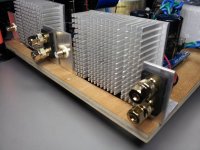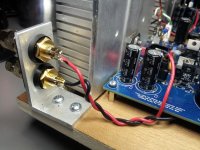Thanks again for a polite and clear explanation of the why's and how's of your development of the FE. Now that I understand that Mauro's concern was with virtual ground/hum, I can pursue better understanding in this direction. Maybe a little experimentation, too.
You're welcome, Jac 🙂
this is correct.........monoblock means a single channel with its own dedicated power supply in its own enclosure. Therefore you will need two enclosures for a stereo setup.
dual mono does not operate in the same way as monoblock. The crucial difference is the connection to PE. A dual mono requires two connections to PE and then the two amplifiers inside the common chassis are now connected. That is the big differenceThough I think what is being said here is that each channel needs its own power supply transformer, rectifier smoothing etc. Dual mono.
the problem is the introduction of hum loops. If you connect a stereo source to a stereo amplifier, you will find that there is a ground loop around the connected system. Draw out the grounding system alone and you will see that loop. Draw out the comparable stereo source into two monoblocks and when you examine then grounding diagram you will find that the grounding loop no longer exists.That being said is there any reason that both channels can't or shouldn't be housed in one enclosure? I have read that there is still crosstalk between the channels, but should there be in a properly operating amp with only grounds meeting at a common point?
build a uncased mono and get it working properly. connect it to PE and check again that it is still working properly.I am still going back and forth with idea of one stereo enclosure or two mono. I guess I will decide when the board and transformer are in front of me.
Then build up a second channel going through the same staged assembly procedure. When you finally connect the second channel to the common PE you will find out if you have a grounding problem. Only then decide if you want to pursue a stereo amplifier, or a pair of monoblocks.
This explanation applies to all Power Amplifiers connected to a stereo Source, not just the MyRefC, or MyRef FE.
Last edited:
You are describing a Disconnecting Network.................. discussions/approaches to grounding, both safety earth and audio, I'll offer another approach I've seen in a high quality pre-amp. Jos Eijndhoven's Relaixed2 pre-amp uses an R22 resistor between the audio ground and the chassis/safety ground. That keeps it from building up voltage on the floating board. It also allows the pcb to float from safety ground and helps kill the hum.
That disconnection between Safety Earth and Main Audio Ground must be capable of passing mains FAULT current back to the mains distribution board. A resistor alone will blow up if FAULT current is passed for more than a few µs (0.000001s to 0.000005s). You MUST fit a properly designed Disconnecting Network, or a heavy wire link between Safety Earth and Main Audio Ground. This link is a life saver !!!!!
You are risking the life of any and every operator by inserting a resistor alone between PE and your circuit.
Last edited:
Since the MyRef input ground is connected to a signal ground which is separated from the power earth, there is actually not ground loop.this is correctdual mono does not operate in the same way as monoblock. The crucial difference is the connection to PE. A dual mono requires two connections to PE and then the two amplifiers inside the common chassis are now connected. That is the big differencethe problem is the introduction of hum loops. If you connect a stereo source to a stereo amplifier, you will find that there is a ground loop around the connected system. Draw out the grounding system alone and you will see that loop. Draw out the comparable stereo source into two monoblocks and when you examine then grounding diagram you will find that the grounding loop no longer exists.build a uncased mono and get it working properly. connect it to PE and check again that it is still working properly.
Then build up a second channel going through the same staged assembly procedure. When you finally connect the second channel to the common PE you will find out if you have a grounding problem. Only then decide if you want to pursue a stereo amplifier, or a pair of monoblocks.
This explanation applies to all Power Amplifiers connected to a stereo Source, not just the MyRefC, or MyRef FE.
The only issue you have is due to the common power earth being connected inside the same chassis is that the two channel power ground currents are now running close to each and will cross couple, you probably get less channel separation.
Soon,
what are you talking about?
The differences between Mono block and dual mono and two channel? or another hypothetical amplifier, or some amplifier I have assembled?
what are you talking about?
The differences between Mono block and dual mono and two channel? or another hypothetical amplifier, or some amplifier I have assembled?
dual mono vs two mono blocks MyRef
MyRef grounding is different from most power amps.
MyRef grounding is different from most power amps.
Last edited:
No it's not. It has a Signal Ground and it has a Power Ground. What's different about that?
This is asking about mono cf. dual mono. What exactly are you trying to say/ask?Since the MyRef input ground is connected to a signal ground which is separated from the power earth, there is actually not ground loop.
The only issue you have is due to the common power earth being connected inside the same chassis is that the two channel power ground currents are now running close to each and will cross couple, you probably get less channel separation.
Precisely what I said in post #947
A more simple way to put it, when you use dual mono configuration for MyRef, you do not get ground loop as you stated, you just get less channel separation.
A more simple way to put it, when you use dual mono configuration for MyRef, you do not get ground loop as you stated, you just get less channel separation.
How sensitive to soldering heat are D1 and D2, the BAV99 ?
After re-flowing everything I dare on my non-working FE board I am ready to take Dario's advice and order new LM318 and LM3886TF for it. I'm considering ordering new BAV99 as well on the off chance that I cooked them during assembly. I do get a relay click on power up but no sound. My smoothing caps (C101,201) do not measure 35V. Would a grounded via at J1 cause this ?
Can anyone suggest any other parts I should order to rebuild this board ? (or as my wife calls it, that $400 worth of junk sitting on my desk) .
I'm glad everyone is so happy with this version but for me, the FE has been a bitter disappointment so far.
After re-flowing everything I dare on my non-working FE board I am ready to take Dario's advice and order new LM318 and LM3886TF for it. I'm considering ordering new BAV99 as well on the off chance that I cooked them during assembly. I do get a relay click on power up but no sound. My smoothing caps (C101,201) do not measure 35V. Would a grounded via at J1 cause this ?
Can anyone suggest any other parts I should order to rebuild this board ? (or as my wife calls it, that $400 worth of junk sitting on my desk) .
I'm glad everyone is so happy with this version but for me, the FE has been a bitter disappointment so far.
Hey. Chin up! The build on my first TP V1.2 board turned on at first power up. The second build was so bad I actually finished both V1.3 builds before returning to my problem child. The errors were a combination of parts mix-ups (using 100 R where 100K was indicated), bad soldering and a few fried components. If the new parts don't solve your issues, transplanting parts to a new PCB might do the trick. It worked for me. Don't know if Dario ordered any spares.
Please keep your posts coming.
P.S. After the kids were grown, I traded my wife for a pair of Klipschorns and a big McIntosh power amp. A little extreme maybe, but I think I got a good deal.😀
Please keep your posts coming.
P.S. After the kids were grown, I traded my wife for a pair of Klipschorns and a big McIntosh power amp. A little extreme maybe, but I think I got a good deal.😀
Last edited:
I'm considering ordering new BAV99 as well on the off chance that I cooked them during assembly.
They cost nothing, so it's a good idea to swap them as well.
Like all semiconductors they don't like much heat.
I do get a relay click on power up but no sound. My smoothing caps (C101,201) do not measure 35V. Would a grounded via at J1 cause this ?
Did you remove LM3886 and LM318?
Please do it and measure again so we can continue troubleshooting.
I'm glad everyone is so happy with this version but for me, the FE has been a bitter disappointment so far.
I can understand your disappointment but 5 boards have been populated and worked from start...let us help you making work also yours 😉
BTW your boards were two of the best so I don't think you have any short (I've checked for continuity them).
I traded my wife for a pair of Klipschorns and a big McIntosh power amp. A little extreme maybe, but I think I got a good deal.😀
We can do that???😀
squalor,
A little clarification. Transferring parts to a different V1.2 board helped me identify my problems and double check my work. In the end I discovered both old and new PCB were good. I certainly hope and think you don't have to go that far.
Dario,
Did you order any extra boards and/or can any be added to this batch?
A little clarification. Transferring parts to a different V1.2 board helped me identify my problems and double check my work. In the end I discovered both old and new PCB were good. I certainly hope and think you don't have to go that far.
Dario,
Did you order any extra boards and/or can any be added to this batch?
Did you order any extra boards and/or can any be added to this batch?
Sadly no to both
Inviato dal mio LG-P500 con Tapatalk 2
Rubbish.Precisely what I said in post #947
A more simple way to put it, when you use dual mono configuration for MyRef, you do not get ground loop as you stated, you just get less channel separation.
Read my post again rather than quote the whole posts, quote the part you want to discuss.
I will say again: When you connect a stereo source to a dual mono you will get a ground loop.
Do as I said in my post. Consider ONLY the grounding. Trace out the grounding and see for yourself the loop formed with a dual mono.
Now again do what I said in my post. Trace out a stereo source into two monoblocks considering ONLY the grounding. You will find that the loop does not exist in this arrangement.
It comes back to reading the post before you make ridiculous claims that you repeat.
- Status
- Not open for further replies.
- Home
- Amplifiers
- Chip Amps
- My_Ref Fremen Edition - Beta build/Fine tuning





